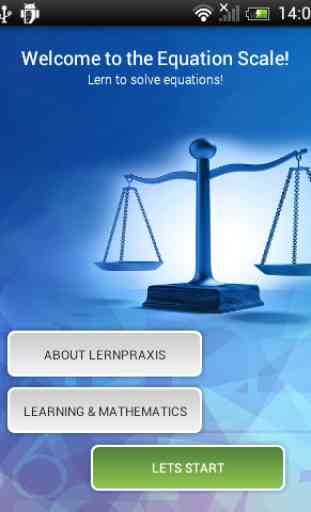Equation Scale
The equation scale
The equation scale is a coaching application that explains mathematical x-equations at different levels of difficulty based on a scale model. It can help you to develop and improve your mathematical performance in no time. A clear, structured design and instant feedback also help older students to solve x-equations reliably. Every child can learn to calculate!
The App
The equation scale helps students aged 10 to 16 years to solve mathematical x-equations. Even difficult tasks can be practiced in a clear and structured manner using the scale model. The design of this application focuses on functionality, and does not contain unnecessary graphics which would distract the user's attention. Clear instructions, instant feedback, and positive reinforcement motivate children and youths to solve x-equations interactively. The task history is always visible, and successes are visualized.
The Scale Model
Mathematical x-equations are formed and solved according to the scale model. The same operations (addition, subtraction, multiplication, division) are carried out to the right and left of the equal sign. The aim is to separate the x-variable from the other numbers so that the result is only a single number opposite the x.
Different Levels of DifficultySix different levels of difficulty can be selected to offer students the perfect training corresponding to their current grade level.
Level 1: The result is a positive number between 0 and 10Level 2: The result is a positive or negative number between 0 and 10Level 3: The result is a positive or negative number, including bracket termsLevel 4: The x-variable can be on either side of the equal signLevel 5: Fractions are includedLevel 6: Difficult equations for mathematical geniuses
Dyscalculia
Dyscalculia is a genetic, congenital difficulty in dealing with numbers. Dyscalculia should not be viewed as an illness or disability, and certainly not as a sign of a lack of intelligence. Dyscalculia can be overcome effectively and permanently through special training. The earlier this training is started, the greater the success.
The Difference between Dyscalculia and Mathematical Impairment
In contrast to dyscalculia, a mathematical impairment is only a temporary phenomenon. It is often caused by psychological or physical problems, or is associated with inadequate teaching methods, or learning deficits. Special tests can determine whether a person has dyscalculia or merely a mathematical impairment.
What are the Symptoms of Dyscalculia?
Seemingly normally gifted children show persistent difficulties in dealing with numbers, number ranges, and basic arithmetic operations. They are noticeably inattentive and restless when they are expected to perform calculations, although they otherwise are be able to concentrate very well. When solving arithmetic problems, they make numerous mistakes, even when solving tasks they have worked on several times.
Causes for Dyscalculia
Children with dyscalculia have a genetic condition which inhibits their focused attention. They have difficulties controlling their thoughts when performing calculations. At the same time, they have a different sensory perception, and, therefore, find it difficult to comprehend numbers, numerical relationships, and arithmetic operations.
Further Information:
The author of the Equation Scale App, Dr. Sabine Kaiser Röhrich, is a dyscalculia trainer, author, and lecturer. When developing the application, she refers to the physiological basis of the brain as well as to her years of experience with children suffering from dyscalculia and mathematical impairment. Further information about the author, dyscalculia, and mathematical impairment can be found at www.dr-kaiser.com.
The equation scale is a coaching application that explains mathematical x-equations at different levels of difficulty based on a scale model. It can help you to develop and improve your mathematical performance in no time. A clear, structured design and instant feedback also help older students to solve x-equations reliably. Every child can learn to calculate!
The App
The equation scale helps students aged 10 to 16 years to solve mathematical x-equations. Even difficult tasks can be practiced in a clear and structured manner using the scale model. The design of this application focuses on functionality, and does not contain unnecessary graphics which would distract the user's attention. Clear instructions, instant feedback, and positive reinforcement motivate children and youths to solve x-equations interactively. The task history is always visible, and successes are visualized.
The Scale Model
Mathematical x-equations are formed and solved according to the scale model. The same operations (addition, subtraction, multiplication, division) are carried out to the right and left of the equal sign. The aim is to separate the x-variable from the other numbers so that the result is only a single number opposite the x.
Different Levels of DifficultySix different levels of difficulty can be selected to offer students the perfect training corresponding to their current grade level.
Level 1: The result is a positive number between 0 and 10Level 2: The result is a positive or negative number between 0 and 10Level 3: The result is a positive or negative number, including bracket termsLevel 4: The x-variable can be on either side of the equal signLevel 5: Fractions are includedLevel 6: Difficult equations for mathematical geniuses
Dyscalculia
Dyscalculia is a genetic, congenital difficulty in dealing with numbers. Dyscalculia should not be viewed as an illness or disability, and certainly not as a sign of a lack of intelligence. Dyscalculia can be overcome effectively and permanently through special training. The earlier this training is started, the greater the success.
The Difference between Dyscalculia and Mathematical Impairment
In contrast to dyscalculia, a mathematical impairment is only a temporary phenomenon. It is often caused by psychological or physical problems, or is associated with inadequate teaching methods, or learning deficits. Special tests can determine whether a person has dyscalculia or merely a mathematical impairment.
What are the Symptoms of Dyscalculia?
Seemingly normally gifted children show persistent difficulties in dealing with numbers, number ranges, and basic arithmetic operations. They are noticeably inattentive and restless when they are expected to perform calculations, although they otherwise are be able to concentrate very well. When solving arithmetic problems, they make numerous mistakes, even when solving tasks they have worked on several times.
Causes for Dyscalculia
Children with dyscalculia have a genetic condition which inhibits their focused attention. They have difficulties controlling their thoughts when performing calculations. At the same time, they have a different sensory perception, and, therefore, find it difficult to comprehend numbers, numerical relationships, and arithmetic operations.
Further Information:
The author of the Equation Scale App, Dr. Sabine Kaiser Röhrich, is a dyscalculia trainer, author, and lecturer. When developing the application, she refers to the physiological basis of the brain as well as to her years of experience with children suffering from dyscalculia and mathematical impairment. Further information about the author, dyscalculia, and mathematical impairment can be found at www.dr-kaiser.com.
Category : Education

Related searches




